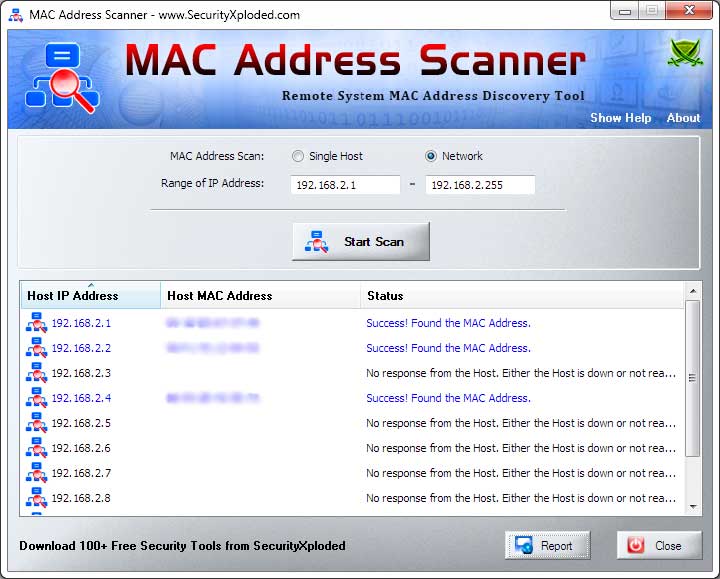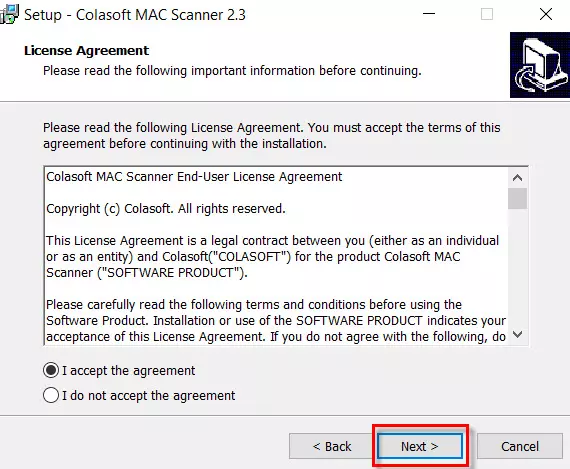
- #Best tool to scan for mac addresses on subnet how to
- #Best tool to scan for mac addresses on subnet software
With the “-p” flag followed by a port, you can scan for information regarding a specific port on a host. Port scanning is one of the basic utilities that Nmap offers and consequently, there are a few ways that this command can be customized. You can also use –version-trace to show more detailed information of the scan if the scan does not come out with the results that you would ordinarily expect. You can use –version-intensity “level” from 0 to 9 to determine the intensity level of this search. This will give you the necessary information regarding the services across the given host. This is useful for troubleshooting, scanning for vulnerabilities, or locating services that need to be updated. Find Information About Service VersionsĪt times, you may need to detect service and version information from open ports.
#Best tool to scan for mac addresses on subnet software
Note: Learn more about penetration testing types and methodologies and penetration testing software in our guides. This uses an ACK scan to receive the information. Using the sA flag will let you know whether a firewall is active on the host. Several functions can be used to detect firewall settings across the given hosts, but the -sA flag is the most common.

Scan to Detect Firewall Settingsĭetecting firewall settings can be useful during penetration testing and vulnerability scans. Again, operating systems are detected based on certain hallmarks: it isn’t a certainty that the information is accurate. The “-osscan-guess” command will be more aggressive about guessing operating systems. The “–osscan-limit” command will only guess easy operating system targets. Additional tags include –osscan-limit and -osscan-guess. Using the -O flag on your Nmap command will reveal further operating system information of the mapped hosts. The -A flag can be used in combination with other Nmap commands. nmap -A 192.168.0.1Īdd in the -A flag on your Nmap command, you can discover the operating system information of the hosts that are mapped. It’s important to note that Nmap will do its best to identify things like operating systems and versions, but it may not always be entirely accurate. In addition to general information, Nmap can also provide operating system detection, script scanning, traceroute, and version detection. This is the easiest way to exclude multiple hosts from your search. You can also exclude a list of hosts from your search using the –exclude flag and linking to a specific file.

You can exclude certain hosts from your search using the –exclude flag. When scanning a network, you may want to select an entire group (such as a whole subnet) while excluding a single host. Use a hyphen to scan a range of IP addresses. Separate different address endings with commas rather than typing out the entire IP address. Use the * wildcard to scan an entire subnet at once. nmap 192.168.0.1 192.168.0.2 192.168.0.3Īdd multiple domains or multiple IP addresses in a row to scan multiple hosts at the same time. There are several ways to scan numerous locations at once, depending on how many locations you need to examine. This is useful for more extensive network infrastructures. Nmap can scan multiple locations at once rather than scanning a single host at a time. Because the -F “Fast Scan” flag does not scan as many ports, it isn’t as thorough. The “-F” flag will list ports on the nmap-services files. If you need to perform a scan quickly, you can use the “-F” flag. Nmap can reveal open services and ports by IP address as well as by domain name.

Without flags, as written above, Nmap reveals open services and ports on the given host or hosts.

A basic Nmap command will produce information about the given host. When scanning hosts, Nmap commands can use server names, IPV4 addresses or IPV6 addresses.
#Best tool to scan for mac addresses on subnet how to
Note: If you don’t have Network Mapper, you can install the software by following our guide on how to install NMAP on Ubuntu 18.04.


 0 kommentar(er)
0 kommentar(er)
